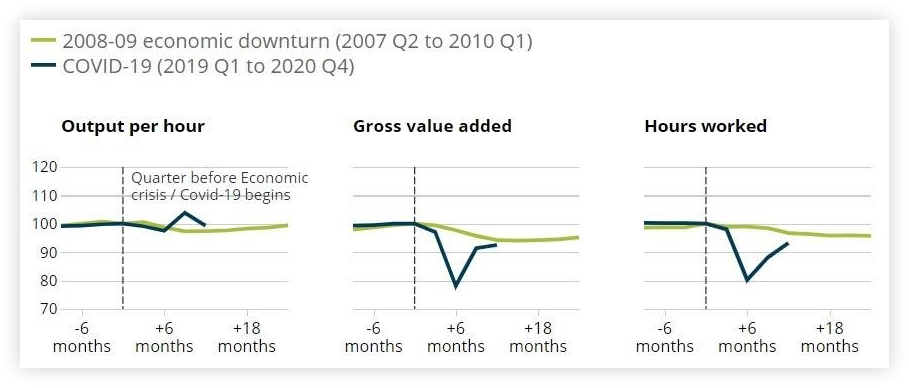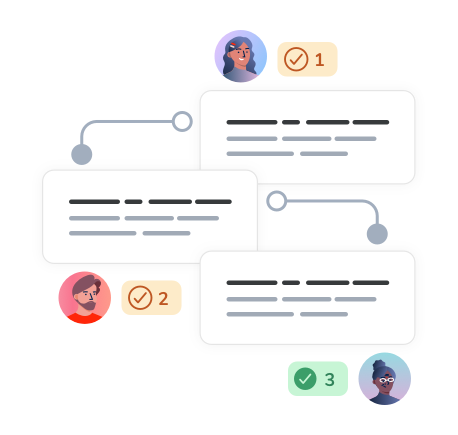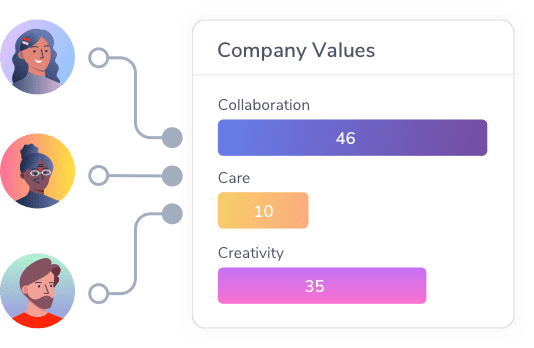Online intranet software is essential for increasing workforce productivity across the next decade.
With the rise of the digital workplace, adapting to flexible working patterns whilst maintaining long-term employee productivity and engagement levels will be a significant consideration for businesses over the coming years.
During lockdown, 62% of UK remote workers said they lacked technology to help them stay connected with the organisation and their co-workers. And, with 25% wanting to maintain some degree of flexibility after the pandemic, you’ll need to figure out how to make this work in the long term.
The ONS notes that in 2020, output per hour worked grew 0.4% compared with 2019 levels – a small increase, but a stark contrast to the steadily-declining productivity levels seen after the 2008-2009 economic downturn. Whilst furloughs have caused a dip in hours worked and gross value added, many signs point to a strong bounce-back.

(Image source: ons.gov.uk)
The fact that, despite everything, productivity metrics are trending upwards is a great starting point. Your employees – whether you have a largely remote workforce or not – have the capacity to be productive if you give them the right tools.
That’s where online intranet software comes in. Cloud-based intranet packages in particular can be a great tool for encouraging workforce productivity, collaboration and cohesion. Below, we highlight five core ways you could use your intranet solution to maximise productivity.
1. Use online intranet software to help employees work more efficiently
How much time do you think your employees spend on low-value administrative tasks?
Let’s start with the classic workplace task of inbox management. According to one recent survey, 25% of employees spend the equivalent of one working day each week managing their inboxes.
Over half (55%) of respondents admitted to feeling frustrated at not finding the right documents in their inbox. This led to them feeling as if they were wasting time (63%), being less productive (48%), or losing track of project information (52%).
That’s just email. Imagine what those figures would look like if you factored in other low/no-value tasks like submitting expenses, finding paperwork, and manually booking leave.
This doesn’t have to be the case.
Online intranet software cuts out inefficient email exchanges with more immediate workplace instant messaging services. It can also automate back-office HR tasks, act as a centralised repository for essential documents, and provide a ‘single source of truth’ for key processes and best practices.

Reduce busywork by automating HR tasks and processes
These features (and more) cut down the low value administrative work your employees do day to day, freeing time for more strategic, creative and value-based contributions to your business.
2. Intranets ensure employees see the information that is relevant to them
Online intranet software is a major facilitator of internal communication, particularly if your workforce is large or dispersed over numerous sites.
Rather than relying on email to get messages across, you can use your intranet. Modern intranets send push notifications to individual users, so you can reach employees immediately, rather than having to rely on them logging into email.
This has two major productivity benefits:
- Employees pick up important, company-wide announcements quicker. Informed employees feel more engaged with your wider organisation – and employee engagement has a significant positive effect on productivity levels.
- Day-to-day communications get through faster, so your workforce can react more quickly to unexpected circumstances, check rota changes and work more efficiently at an operational level.
This has the potential to massively reduce the number of times your team is down a person due to illness with no cover. Using your intranet, your line managers can organise replacement shifts, rearrange rotas, and spread the word quickly so that productivity doesn’t suffer, and remaining team members aren’t overworked.
It’s quicker, easier, and more effective than trying to organise people over text or phone – and means that you don’t need to rely on employees checking email during off hours.
3. Intranets align with your business objectives and values
As stated above, employee engagement is a major productivity driver. To create and maintain an engaged workforce, however, you’ll need to do more than keep your employees informed. You’ll need to build a company culture that inspires employees to work as hard as they can.
Employees who feel like a valued member of a wider organisation with defined and worthwhile objectives are happier in their roles, more productive, and perform better at work. Thanks to numerous social and collaboration tools, online intranets can be invaluable in creating the sense of togetherness your employees need to thrive.

Intranet collaboration tools help you align your company values
Social intranet software features like two-way sharing, tagging and social feeds help employees make connections across your organisation, share knowledge and best practice, and celebrate major successes.
4. Online intranet software can break down silos
Siloed knowledge within organisations is a huge barrier to employee productivity. Even when intra-departmental collaboration works exceptionally, productivity slows when external knowledge is required.
This is often due to a lack of collaborative technology, not knowing where to look for specific expertise, or a simple consequence of different departments having different priorities.
Online intranet software makes it significantly easier to bridge this gap. Instant messaging tools and employee directories make it faster to find and message people quickly. Users can also ask open-ended questions about expertise on social feeds, using their network to find the right source of information.
Social tools offered by online intranets also include discussion threads and forums. These make knowledge transfer across the organisation significantly easier, as anyone can share their opinions and experiences. Your best practices improve as a result, and your organisation becomes more cohesive.
5. Online intranet software provides access on the go
One of the great advantages of cloud-based online intranet software is that it can be accessed anywhere. When you use online intranet software, employees can access the information they need for their job without barriers – which improves employee experience significantly for remote employees and frontline workers.
If your frontline teams can access updates on the go, for example, they can adapt immediately rather than having to take a break from work to check their email, the staff noticeboard, or wait for an update from their line manager.
Empowering frontline teams has a huge effect on productivity according to the Harvard Business Review. In a recent survey, 72% of respondents reported increased productivity after empowering their frontline workforces.
A huge part of this empowerment involves integration with your wider organisation – for example, keeping them in the loop about important announcements, celebrating their individual successes as well as those of the wider organisation, and keeping them regularly updated about their shift patterns.
Cloud based intranet software with a native mobile app is an ideal way to do this. Easy to use and access, a mobile intranet gives your frontline teams the same access to key documents and time-saving automated processes as your head office.






